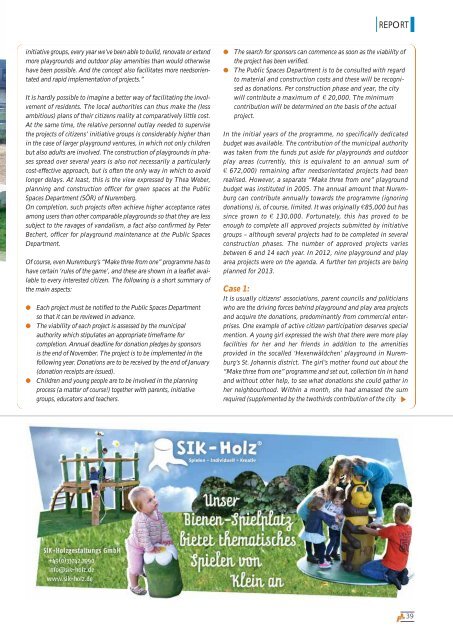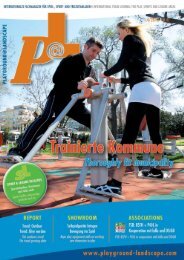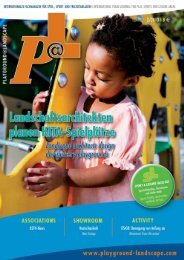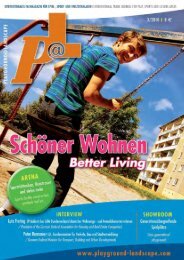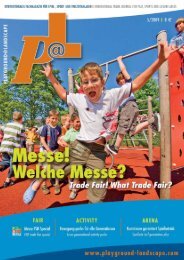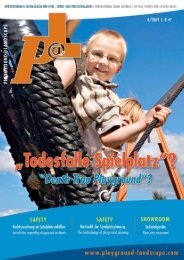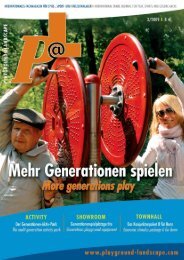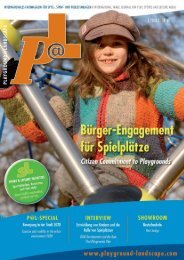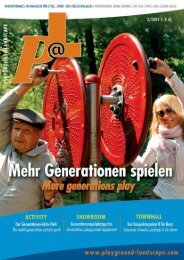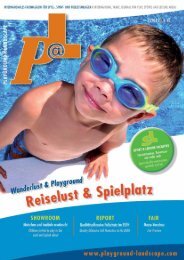Deutsch-Park - Playground@Landscape
Deutsch-Park - Playground@Landscape
Deutsch-Park - Playground@Landscape
Sie wollen auch ein ePaper? Erhöhen Sie die Reichweite Ihrer Titel.
YUMPU macht aus Druck-PDFs automatisch weboptimierte ePaper, die Google liebt.
REPORT<br />
initiative groups, every year we’ve been able to build, renovate or extend<br />
more playgrounds and outdoor play amenities than would otherwise<br />
have been possible. And the concept also facilitates more needsorientated<br />
and rapid implementation of projects.”<br />
It is hardly possible to imagine a better way of facilitating the involvement<br />
of residents. The local authorities can thus make the (less<br />
ambitious) plans of their citizens reality at comparatively little cost.<br />
At the same time, the relative personnel outlay needed to supervise<br />
the projects of citizens’ initiative groups is considerably higher than<br />
in the case of larger playground ventures, in which not only children<br />
but also adults are involved. The construction of playgrounds in phases<br />
spread over several years is also not necessarily a particularly<br />
cost-effective approach, but is often the only way in which to avoid<br />
longer delays. At least, this is the view expressed by Thea Weber,<br />
planning and construction officer for green spaces at the Public<br />
Spaces Department (SÖR) of Nuremberg.<br />
On completion, such projects often achieve higher acceptance rates<br />
among users than other comparable playgrounds so that they are less<br />
subject to the ravages of vandalism, a fact also confirmed by Peter<br />
Bechert, officer for playground maintenance at the Public Spaces<br />
Department.<br />
Of course, even Nuremburg’s “Make three from one” programme has to<br />
have certain ‘rules of the game’, and these are shown in a leaflet available<br />
to every interested citizen. The following is a short summary of<br />
the main aspects:<br />
●<br />
●<br />
●<br />
Each project must be notified to the Public Spaces Department<br />
so that it can be reviewed in advance.<br />
The viability of each project is assessed by the municipal<br />
authority which stipulates an appropriate timeframe for<br />
completion. Annual deadline for donation pledges by sponsors<br />
is the end of November. The project is to be implemented in the<br />
following year. Donations are to be received by the end of January<br />
(donation receipts are issued).<br />
Children and young people are to be involved in the planning<br />
process (a matter of course!) together with parents, initiative<br />
groups, educators and teachers.<br />
●<br />
●<br />
The search for sponsors can commence as soon as the viability of<br />
the project has been verified.<br />
The Public Spaces Department is to be consulted with regard<br />
to material and construction costs and these will be recognised<br />
as donations. Per construction phase and year, the city<br />
will contribute a maximum of h 20,000. The minimum<br />
contribution will be determined on the basis of the actual<br />
project.<br />
In the initial years of the programme, no specifically dedicated<br />
budget was available. The contribution of the municipal authority<br />
was taken from the funds put aside for playgrounds and outdoor<br />
play areas (currently, this is equivalent to an annual sum of<br />
h 672,000) remaining after needsorientated projects had been<br />
realised. However, a separate “Make three from one” playground<br />
budget was instituted in 2005. The annual amount that Nuremburg<br />
can contribute annually towards the programme (ignoring<br />
donations) is, of course, limited. It was originally h85,000 but has<br />
since grown to h 130,000. Fortunately, this has proved to be<br />
enough to complete all approved projects submitted by initiative<br />
groups – although several projects had to be completed in several<br />
construction phases. The number of approved projects varies<br />
between 6 and 14 each year. In 2012, nine playground and play<br />
area projects were on the agenda. A further ten projects are being<br />
planned for 2013.<br />
Case 1:<br />
It is usually citizens' associations, parent councils and politicians<br />
who are the driving forces behind playground and play area projects<br />
and acquire the donations, predominantly from commercial enterprises.<br />
One example of active citizen participation deserves special<br />
mention. A young girl expressed the wish that there were more play<br />
facilities for her and her friends in addition to the amenities<br />
provided in the socalled ‘Hexenwäldchen’ playground in Nuremburg’s<br />
St. Johannis district. The girl’s mother found out about the<br />
“Make three from one” programme and set out, collection tin in hand<br />
and without other help, to see what donations she could gather in<br />
her neighbourhood. Within a month, she had amassed the sum<br />
required (supplemented by the twothirds contribution of the city<br />
39


